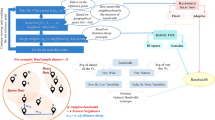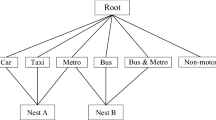Abstract
Given the recent growth of bicycle-sharing systems (BSS) around the world, it is of interest to BSS operators/analysts to identify contributing factors that influence individuals’ decision processes in adoption and usage of bicycle-sharing systems. The current study contributes to research on BSS by examining user behavior at a trip level. Specifically, we study the decision process involved in identifying destination locations after picking up the bicycle at a BSS station. In the traditional destination/location choice approaches, the model frameworks implicitly assume that the influence of exogenous factors on the destination preferences is constant across the entire population. We propose a finite mixture multinomial logit (FMMNL) model that accommodates such heterogeneity by probabilistically assigning trips to different segments and estimate segment-specific destination choice models for each segment. Unlike the traditional destination choice based multinomial logit (MNL) model or mixed multinomial logit (MMNL), in an FMMNL model, we can consider the effect of fixed attributes across destinations such as users’ or origins’ attributes in the decision process. Using data from New York City bicycle-sharing system (CitiBike) for 2014, we develop separate models for members and non-members. We validate our models using hold-out samples and compare our proposed FMMNL model results with the traditional MNL and MMNL model results. The proposed FMMNL model provides better results in terms of goodness of fit measures, explanatory power and prediction performance.
Similar content being viewed by others
Notes
To be sure, random sampling of alternative might affect parameter estimates in the FMMNL model. Random sampling does not introduce a bias in the estimation process for simple multinomial logit model. However, based on recent research by Guevara and Ben-Akiva (2013) there is evidence to suggest that the naïve estimator (i.e. employing random sampling based estimation) offers reasonable accuracy in model estimation for MMNL model. We conducted a comparison exercise with different number of alternatives for the FMMNL model and observed relatively similar parameters with increasing choice set size (similar to MMNL).
For sake of brevity, we did not include the mathematical formulations for MNL and MMNL models.
References
Anowar, S., Yasmin, S., Eluru, N., Miranda-Moreno, L.: Analyzing car ownership in Quebec City: a comparison of traditional and latent class ordered and unordered models. Transportation 41, 1013–1039 (2014)
Bachand-Marleau, J., Lee, B., El-Geneidy, A.: Better understanding of factors influencing likelihood of using shared bicycle systems and frequency of use. Transp. Res. Rec. J. Transp. Res. Board 2314, 66–71 (2012)
Bhat, C.R.: Endogenous segmentation mode choice model with an application to intercity travel. Transp. Sci. 31, 34–48 (1997)
Bouveyron, C., Côme, E., Jacques, J.: The discriminative functional mixture model for a comparative analysis of bike sharing systems. Ann. Appl. Stat. 9, 1726–1760 (2015)
Buck, D., Buehler, D., Happ, P., Rawls, B., Chung, P., Borecki, N.: Are bikeshare users different from regular cyclists? A first look at short-term users, annual members, and area cyclists in the Washington, D.C., region. Transp. Res. Rec. J. Transp. Res. Board 2387, 112–119 (2013)
Chakour, V., Eluru, N.: Analyzing commuter train user behavior: a decision framework for access mode and station choice. Transportation 41, 211–228 (2014)
Davis, B., Dutzik, T., Baxandall, P.: Transportation and the new generation: why young people are driving less and what it means for transportation policy. Frontier Group, New York (2012)
Eluru, N., Bagheri, M., Miranda-Moreno, L., Fu, L.: A latent class modelling approach for identifying vehicle driver injury severity factors at highway-railway crossings. Accid. Anal. Prev. 47, 119–127 (2012)
Ettema, D.F.: The impact of telecommuting on residential relocation and residential preferences: a latent class modeling approach. J. Transp. Land Use 3, 7–24 (2010)
Faghih-Imani, A., Hampshire, R., Marla, L., Eluru, N.: An empirical analysis of bike sharing usage and rebalancing: evidence from Barcelona and Seville. Transp. Res. Part A Policy Pract. 97, 177–191 (2017)
Faghih-Imani, A., Eluru, N.: Determining the role of bicycle sharing system infrastructure installation decision on usage: case study of montreal BIXI system. Transp. Res. Part A 94C, 685–698 (2016a)
Faghih-Imani, A., Eluru, N.: Analyzing bicycle sharing system user destination choice preferences: an investigation of Chicago’s Divvy system. J. Transp. Geogr. 44, 53–64 (2015)
Faghih-Imani, A., Eluru, N.: Incorporating the impact of spatio-temporal interactions on bicycle sharing system demand: a case study of New York CitiBike system. J. Transp. Geogr. 54, 218–227 (2016b)
Faghih-Imani, A., Eluru, N.: Examining the impact of sample size in the analysis of bicycle-sharing systems. Transp. A Transp. Sci. 13, 139–161 (2017)
Faghih-Imani, A., Eluru, N., El-Geneidy, A., Rabbat, M., Haq, U.: How land-use and urban form impact bicycle flows: evidence from the bicycle-sharing system (BIXI) in Montreal. J. Transp. Geogr. 41, 306–314 (2014)
Fishman, E., Schepers, P.: Global bike share: what the data tells us about road safety. J. Saf. Res. 56, 41–45 (2016)
Fishman, E.: Bikeshare: a review of recent literature. Transp. Rev. 36, 92–113 (2016)
Fishman, E., Washington, S., Haworth, N.: Bike share’s impact on car use: evidence from the United States, Great Britain, and Australia. Transp. Res. Part D: Transp. Environ. 31, 13–20 (2014)
Fishman, E., Washington, S., Haworth, N.: Bikeshare’s impact on active travel: evidence from the United States, Great Britain, and Australia. J. Transp. Health 2, 135–142 (2015a)
Fishman, E., Washington, S., Haworth, N., Watson, A.: Factors influencing bike share membership: an analysis of Melbourne and Brisbane. Transp. Res. Part A Policy Pract. 71, 17–30 (2015b)
Forma, I.A., Raviv, T., Tzur, M.: A 3-step math heuristic for the static repositioning problem in bike-sharing systems. Transp. Res. Part B Methodol. 71, 230–247 (2015)
Fricker, C., Gast, N.: Incentives and redistribution in homogeneous bike-sharingsystems with stations of finite capacity. EURO J. Transp. Logist. 5, 261–291 (2016)
Gebhart, K., Noland, R.: The impact of weather conditions on bikeshare trips in Washington, DC. Transportation 41, 1205–1225 (2014)
González, F., Melo-Riquelme, C., de Grange, L.: A combined destination and route choice model for a bicycle sharing system. Transportation 43, 407–423 (2015)
Goodman, A., Green, J., Woodcock, J.: The role of bicycle sharing systems in normalising the image of cycling: an observational study of London cyclists. J. Transp. Health 1, 5–8 (2014)
Graves, J.M., Pless, B., Moore, L., Nathens, A.B., Hunte, G., Rivara, F.P.: Public bicycle share programs and head injuries. Am. J. Public Health 104, 106–111 (2014)
Guevara, C.A., Ben-Akiva, M.E.: Sampling of alternatives in logit mixture models. Transp. Res. Part B Methodol. 58, 185–198 (2013)
Jäppinen, S., Toivonen, T., Salonen, M.: Modelling the potential effect of shared bicycles on public transport travel times in Greater Helsinki: an open data approach. Appl. Geogr. 43, 13–24 (2013)
Kaufman, S.M., Gordon-Koven, L., Levenson, N., Moss, M.L.: Citi Bike: the first 2 years. The Rudin Center for Transportation Policy and Management (2015). http://wagner.nyu.edu/rudincenter/wp-content/uploads/2015/06/Citi_Bike_First_Two_Years_RudinCenter.pdf. Accessed 6 June 2016
Kemperman, A., Timmerman, H.: Influences of built environment on walking and cycling by latent segments of aging population. Transp. Res. Rec. J. Transp. Res. Board 2134, 1–9 (2009)
Kraemer, J.D., Roffenbender, J.S., Anderko, L.: Helmet wearing among users of a public bicycle-sharing program in the District of Columbia and comparable riders on personal bicycles. Am. J. Public Health 102, 23–25 (2012)
Ma, T.Y., Gerber, P., Carpentier, S., Klein, S.: Mode choice with latent preference heterogeneity: a case study for employees of the EU institutions in Luxembourg. Transp. A: Transp. Sci. 11, 441–463 (2015)
Martin, E.W., Shaheen, S.A.: Evaluating public transit modal shift dynamics in response to bikesharing: a tale of two US cities. J. Transp. Geogr. 41, 315–324 (2014)
McLeod, K.: Where We Ride: analysis of bicycle commuting in american cities, league of American bicyclists (2014). http://bikeleague.org/sites/default/files/Where_We_Ride_2014_data_web.pdf. Accessed 19 July 2016
Meddin, R., DeMaio, P.: The bike-sharing world map. http://www.bikesharingworld.com. Accessed 20 June 2016
Murphy, E., Usher, J.: The role of bicycle-sharing in the city: analysis of the Irish experience. Int. J. Sustain. Transp. 9, 116–125 (2015)
Nair, R., Miller-Hooks, E., Hampshire, R.C., Bušić, A.: Large-scale vehicle sharing systems: analysis of Vélib’. Int. J. Sustain. Transp. 7, 85–106 (2013)
O’Brien, O., Cheshire, J., Batty, M.: Mining bicycle sharing data for generating insights into sustainable transport systems. J. Transp. Geogr. 34, 262–273 (2014)
Pfrommer, J., Warrington, J., Schildbach, G., Morari, M.: Dynamic vehicle redistribution and online price incentives in shared mobility systems. IEEE Trans. Intell. Transp. Syst. 15, 1567–1578 (2014)
Raviv, T., Tzur, M., Forma, I.A.: Static repositioning in a bike-sharing system: models and solution approaches. EURO J. Transp. Logist. 2, 187–229 (2013)
Rixey, R.: Station-level forecasting of bikesharing ridership: station network effects in three U.S. systems. Transp. Res. Rec. J. Transp. Res. Board 2387, 46–55 (2013)
Sobhani, A., Eluru, N., Faghih-Imani, A.: A latent segmentation based multiple discrete continuous extreme value model. Transp. Res. Part B Methodol. 58, 154–169 (2013)
Vij, A., Carrel, A., Walker, J.L.: Incorporating the influence of latent modal preferences on travel mode choice behavior. Transp. Res. Part A Policy Pract. 54, 164–178 (2013)
Vogel, P., Mattfeld, D.C.: Strategic and operational planning of bike-sharing systems by data mining—a case study. In: International Conference on Computational Logistics, pp. 127–141. Springer, Berlin (2011)
Waddell, P., Bhat, C.R., Eluru, N., Wang, L., Pendyala, R.M.: Modeling the interdependence in household residence and workplace choices. Transp. Res. Rec. J. Transp. Res. Board 2007, 84–92 (2007)
Walker, J.L., Li, J.: Latent lifestyle preferences and household location decisions. J. Geogr. Syst. 9, 77–101 (2007)
Wang, X., Lindsey, G., Schoner, J., Harrison, A.: Modeling bike share station activity: effects of nearby businesses and jobs on trips to and from stations. J. Urban Plan. Dev. 142, 1–9 (2015)
Yasmin, S., Eluru, N., Bhat, C.R., Tay, R.: A latent segmentation generalized ordered logit model to examine factors influencing driver injury severity. Anal. Methods Accid. Res. 1, 23–38 (2014)
Acknowledgements
The authors would like to acknowledge insightful feedback on an earlier version of the manuscript from two anonymous reviewers and the editor.
Author information
Authors and Affiliations
Corresponding author
Ethics declarations
Conflict of interest
On behalf of all authors, the corresponding author states that there is no conflict of interest.
Rights and permissions
About this article
Cite this article
Faghih-Imani, A., Eluru, N. A finite mixture modeling approach to examine New York City bicycle sharing system (CitiBike) users’ destination preferences. Transportation 47, 529–553 (2020). https://doi.org/10.1007/s11116-018-9896-1
Published:
Issue Date:
DOI: https://doi.org/10.1007/s11116-018-9896-1




